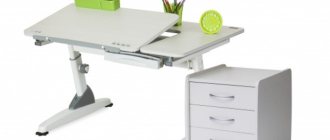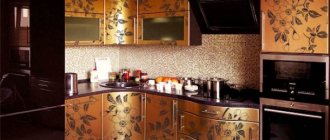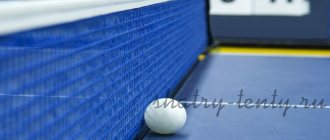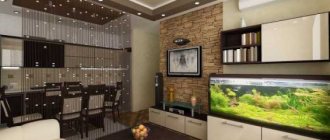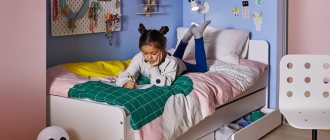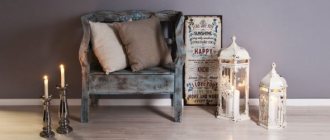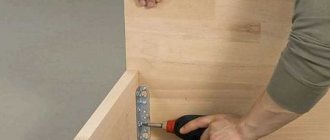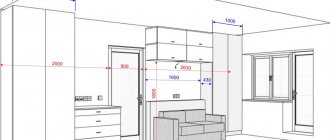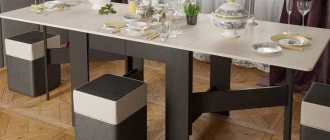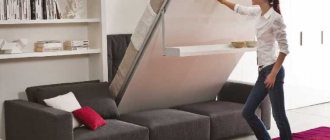15774
Children are the future of any state and society; they will change the usual way of life and make discoveries. They have in their arsenal a store of knowledge acquired by their predecessors. To put all this knowledge into the heads of children, competent teachers and mentors will be required. Schools train young geniuses, but it will be difficult for anyone to comprehend the material if the classroom environment is not cozy and comfortable. Comfortable and functional school furniture allows children to sit comfortably in the classroom and thoughtfully complete assignments. Special furniture sets are located not only in classrooms, but also in libraries, assembly halls and other premises of the educational institution.
Requirements
Standardized labeling indicators are specified in the regulatory document GOST 22046-2016 “Furniture for educational institutions. General technical conditions". This standard was approved by the Interstate Council for Standardization and is applied throughout Russia. According to this legislative draft, the bulk purchase of student equipment is permitted, which has undergone a preliminary strength test, taking into account the relevant documentation.
Legal requirements
The technology requirements are set out in the regulatory document GOST 22046-2016 “Furniture for educational institutions. General technical conditions", which is an interstate standard for Russia, approved by the Interstate Council for Standardization, Metrology and Certification on December 19, 2021.
The general requirements correspond to the state standard. A unified documented regulation allows for the mass purchase of student furniture for schools in all regions of Russia. All products undergo strength tests in accordance with the prescribed documentation.
School furniture according to GOST 22046-2016 must have the following parameters:
- The gloss of the coating does not exceed the permissible 49%.
- The surface is easy to clean. Science classroom tables are equipped with protection against reagents.
- The work surface meets current durability standards.
Requirements for assembling school furniture sets:
- All structural elements are securely fixed.
- Hardware parts cannot be separated by hand.
- Any unevenness on the exterior of furniture is unacceptable. Sharp edges should be rounded. The openings of metal pipes with a diameter greater than 7 mm are closed or hidden.
- Staining elements are hidden.
Proper fixation of large furniture is regulated by GOST 22360-95:
- The structural elements are carefully connected to each other and cannot be disassembled manually.
- If a stand is provided, its connection to the object must be reliable.
Furniture in the school has special markings, which are written in Russian or the official language of the region. Placement of marks on work surfaces is not permitted. It is necessary to mark desks with colored stickers corresponding to height categories according to GOST 11015, 11016.
The marking contains the following:
- information about the manufacturer;
- his contact details;
- trademark;
- description of the purpose of the item;
- designation of the current standard;
- production date, warranty period.
Prefabricated furniture with many parts may not be marked immediately upon manufacture, but should receive one upon packaging. It is necessary to have instructions containing the installation sequence with the obligatory presence of at least one picture demonstrating what the educational furniture will look like when assembled.
Business Solutions
- shops clothing, shoes, groceries, toys, cosmetics, appliances Read more
- warehouses
material, in-production, sales and transport organizations Read more
- marking
tobacco, shoes, consumer goods, medicines Read more
- production
meat, procurement, machining, assembly and installation Read more
- rfid
radio frequency identification of inventory items More details
- egais
automation of accounting operations with alcoholic beverages Read more
Furnished products for student use must have the following parameters:
- The gloss of the coating is no more than 49%.
- The working surface is easy to clean from dirt. Science classroom tables are equipped with a protective layer against chemicals.
- Compliance with all epidemiological standards.
The dimensions of educational furniture and its marking at school (according to SanPiN) are far from the only conditions that must be met. Requirements are also put forward for assembly:
- Reliable fixation of all structural parts.
- Impossibility of manually separating hardware elements.
- The absence of any irregularities on the outer surface. Sharp edges are rounded and holes in metal pipes with a diameter greater than 7 mm are closed or hidden.
- Contaminating parts are hidden.
GOST 22360-95 regulates the proper fixation of large objects:
- A strong and immovable connection of all parts of the structure and the impossibility of disassembling it manually.
- Reliable fastening of the stand (if available) to the object.
Furniture used in educational institutions must have special markings, which are indicated in Russian or the official regional language. It is prohibited to make any marks on the work surface. Tables are marked using special colored stickers that correspond to the height categories of GOST 11015 and 11016.
Desk number (according to Sanitary Regulations) and the size of educational furniture according to the student’s height, table
Experts have developed a size table that provides for the division of furniture into 6 groups. Such a classification makes it possible to differentiate it depending on the growth of children, thanks to which they can sit safely and comfortably at tables without damaging their eyesight or posture while doing any work (reading, writing, drawing and much more).
Tables in subject rooms
In classrooms for studying certain school subjects, tables with special equipment are used. The dimensions of the tabletops are calculated taking into account sufficient space for carrying out educational activities and placing equipment. Depending on the type of educational subject, the workplace is equipped with superstructures, water supply and sewerage (chemistry), power supply, compressed air (physics), sound and language equipment (foreign languages).
For subject rooms attended by middle and high school students (different height groups), it is convenient to purchase models with adjustable tabletop heights. The length of the table is 120-140 cm.
Laboratory tables are designed for two students. In schools with a small number of students, single desks can also be used.
How many height sizes are there for school furniture?
The size chart is based on various indicators: the height of the child, the height of the table and chair. Then the distribution and selection of optimal furniture products were carried out, which are manufactured for use in educational institutions. Today there are 6 main groups. There is also a zero one, but it is relevant for preschool institutions. The first two groups are practically not used, since they assume the height of first-graders to be less than 130 cm.
The above table for the size of desks in elementary schools according to SanPiN will help to compare the requirements of the standards with actual readings. With its help, you can correctly (from the legal point of view) purchase and arrange equipment that will pass any inspections and also ensure the most comfortable learning process.
The right school furniture
Currently, much attention is paid to the issue of improving learning conditions, and an important place is occupied by the issue of equipping schools with furniture that meets sanitary and hygienic requirements and GOSTs.
Indeed, during training sessions, the student’s body experiences a static load due to the need to maintain a forced working posture for a long time. And this load increases sharply in the case of improper arrangement of furniture, a discrepancy between its size and the height and proportions of the students’ bodies - accordingly, conditions arise that contribute to poor posture, the development of myopia and its progression.
The hygienic requirements for school furniture primarily concern its size.
Special measurements have established that the average values of individual body parameters, which serve to standardize the basic dimensions of furniture and their ratios, do not differ significantly when the height of children and adolescents fluctuates within ten to fifteen centimeters.
Since 1972, a height scale with intervals of 15 centimeters has been adopted for schoolchildren. When revising the standards for school furniture in 1986, in connection with the development of CMEA standards for student tables and chairs (ST CMEV 5418 - 85, ST CMEV 5419 - 85) and the introduction of education for children from the age of six, a new numbering of height groups was introduced (six numbers) and color marking of products corresponding to the international standard ISO 5970 “Furniture. Tables and chairs for educational institutions.” In 1992, State Standards “School furniture. Functional dimensions" (GOST 11015, GOST 11016, GOST 5994, GOST 18314, GOST 19549, GOST 19550, GOST 22359, GOST 18313, GOST 18607, etc.) were once again revised and the need for six height numbers was confirmed. Since 1994, mandatory certification of school furniture has been carried out
Today, the main regulatory document regulating the requirements for educational furniture is the revised and updated GOST 22046-02 “Furniture for educational institutions. Technical specifications”, which comes into force on July 1, 2003.
In addition, types, functional dimensions and requirements for educational furniture are defined in the following GOSTs:
GOST 5994 – 93 Desks. Types and functional sizes.
GOST 18607 – 93 Demonstration tables. Types and functional sizes.
GOST 18313 – 93 Tables for teachers. Types and functional sizes.
GOST 22361 – 95 Stands for technical teaching aids. Types and functional sizes.
GOST 20064 – 86 Blackboards. General technical requirements.
GOST 22359 – 95 Chairs for assembly halls. Types and functional sizes.
GOST 18666 – 95 Cabinets for teaching aids. Types and functional sizes.
GOST 22360 – 95 Demonstration and laboratory fume hoods. Types and functional sizes.
GOST 20902 – 95 School dining tables. Types and functional sizes.
GOST 19550 – 93 Student tables for foreign language classrooms. Types and functional sizes.
GOST 19549 – 93 Student tables for drawing and drawing. Types and functional sizes.
GOST 18314 – 93 Student laboratory tables. Functional dimensions.
GOST 23381 – 83 Student chairs made of wood and with a metal frame. Test methods.
GOST 23380 – 83 Student tables made of wood and with a metal frame. Test methods.
GOST 11016 – 93 Student chairs. Types and functional sizes.
GOST 11015 – 93 Student tables. Types and functional sizes.
All these documents fully reflect the criteria and requirements that apply to educational furniture, including pedagogical, sanitary and hygienic, ergonomic, production, economic and architectural and artistic.
Service life
, during which school furniture must maintain its functional and quality characteristics:
- student desk - at least 10 years,
- student chair - up to 5 years,
— cabinets for teaching aids – at least 20 years.
The basis for properly equipping schools with furniture is the availability of the necessary sets of student furniture in groups in accordance with the actual distribution of children (this is of particular importance in primary schools).
School desks must match the height and age of the student and ensure proper seating.
After all, the results of an incorrectly arranged desk can be
-visual impairment;
-rachiocampsis;
-excessive muscle tension and fatigue;
- tightness of breathing, internal organs, etc.
The main parameters of the desk, which must meet established standards in order to ensure the correct seating of the child, are distance and differentiation. In addition, the width of the bench, the height of the bench, the tilt of the table, etc. are standardized.
Also, school furniture must meet injury safety requirements.
. This is ensured by rounding the corners of the tabletops on all types of tables, the use of ABS plastic edges in the edging of the tabletops, the use of a round pipe profile for the table frame, the use of a mechanism for adjusting the supports of the table and cabinets according to the unevenness of the floor, as well as the increased stability of the table and chair structure.
For ease of transportation, educational furniture is most often supplied disassembled.
It should be noted that furniture assembly is an important stage of the production and technological cycle. The durability of the product largely depends on the quality of this operation. Furniture assembly in our company is carried out by highly qualified and experienced specialists. Our company has more than 7 years of experience in the supply of school furniture.
It is important to consider that when equipping special classrooms, such as chemistry, physics, biology, computer and language labs, it is necessary to use specialized furniture.
Particular attention should be paid to compliance with technical safety rules and sanitary and hygienic standards.
When revising the standards for school furniture in 1986, in connection with the development of CMEA standards for student tables and chairs (ST CMEV 5418 - 85, ST CMEV 5419 - 85) and the introduction of education for children from the age of six, a new numbering of height groups was introduced (six numbers) and color marking of products corresponding to the international standard ISO 5970 “Furniture. Tables and chairs for educational institutions." In 1992, State Standards “School furniture. Functional dimensions" (GOST 11015, GOST 11016, GOST 5994, GOST 18314, GOST 19549, GOST 19550, GOST 22359, GOST 18313, GOST 18607, etc.) were once again revised and the need for six height numbers was confirmed. Since 1994, mandatory certification of school furniture has been carried out
Marking of school furniture.
Desks, tables and chairs manufactured in accordance with GOST standards must have numerical and color markings.
On the lower surfaces of the table cover and chair seat, on the inner surfaces of the desk cover and seat, the designation of the furniture number (in the numerator) and the height range of the schoolchildren for whom the furniture is intended (in the denominator) are applied.
For example:
___2_______ ____4_____
115-130 cm 145-160 cm
Color marking of furniture is applied on both sides of the table (desk), chair in the form of a circle with a diameter of at least 10 mm or a horizontal strip with a size of at least 10x15 mm and must be visible from the aisle between the rows.
Arrangement of school furniture
Furniture from smaller rooms (for example, No. 2) is placed in front of each row, followed by larger ones.
numbers (for example, No. 3, No. 4). Furniture No. 1 is placed first in all three (four) rows, second
No. 2 or group A, third No. 3 or group B. If it is necessary to place furniture of a larger number, closer to the board, it should be placed only in the outer first or third (fourth) rows.
Workplaces in classrooms at the first or second tables (desks) in any row are assigned to schoolchildren with a significant decrease in hearing acuity (spoken speech is perceived from 2 to 4 m, and whispered speech from 0.5 to 1 m). Schoolchildren with reduced visual acuity are assigned seats closer to the window at the first tables (desks), where the most favorable lighting conditions with natural light are provided. With good visual acuity correction with glasses, schoolchildren can sit in any row.
For schoolchildren with rheumatic diseases, prone to frequent sore throats and acute inflammation of the respiratory tract, work places are allocated further from the windows.
At least 2 times a year, schoolchildren sitting in the outer first and third (fourth) rows are changed places, without disturbing the correspondence of the furniture numbers to the height of the students. This is necessary to prevent posture and vision.
The dimensions of passages and distances between equipment in classrooms in cm are established as follows:
-Between rows of double tables at least 60 cm;
-Between rows of single tables at least 50 cm;
-Between rows of tables and the outer longitudinal wall at least 70 cm (in buildings made of brick and local materials at least 50 mm);
-Between rows of tables and the internal longitudinal wall (partition) or cabinets standing along the wall, at least 70 mm (in brick buildings, at least 50 cm);
-From the front wall with a chalkboard to the front tables of all rows with a three-row and for the middle rows with a four-row arrangement of double tables 170 - 200 cm, and in laboratories (if there is a demonstration table, at least 225 mm);
-From the front wall with the chalkboard to the first double tables in the outer rows with a four-row arrangement of at least 225 cm;
-From the back tables to the back wall (partition) at least 65 cm, and if the wall is external at least 100 mm;
- From the back tables to the cabinets standing along the back wall, at least 80 mm, and when creating an entrance to the classroom from the rear tables, at least 120 cm;
-Between tables in a row is at least 50 cm;
-Between the teacher’s desk and the front wall is at least 65 cm;
-From the demonstration table to the blackboard at least 100 cm;
-Between the teacher’s table and the first student’s table is at least 50 cm;
-The angle of visibility of the board (from the edge of the board 3 meters long to the middle of the student’s extreme position at the front table) is taken in the first classes and laboratories to be no less than 45 degrees, in the second to fourth grades 40 degrees, in classrooms of other classes no less than 35 degrees.
Measuring the height of schoolchildren
The height of schoolchildren is measured in ordinary shoes using a stadiometer or a special 2m long rod. On one side of the slats, divisions are applied at intervals of 15 cm, starting from 100 cm. In the intervals between divisions, numbers (groups) of furniture are placed.
If the growth data of schoolchildren available in medical records is used, then in this case 2 cm for shoes is added to the height indicator.
The teacher, class teacher or head of the office, taking into account the received data on the growth of schoolchildren, seats them at desks or tables of the corresponding number (group).
At the moment, there are many school furniture manufacturers who offer to buy school furniture from them, but schools cannot afford to buy directly from the school furniture manufacturer due to the fact that they will have to pay for delivery. For this reason, schools and other educational institutions buy furniture in stores. Our company works directly with manufacturers who produce from children's school furniture to the oldest age group. We sell cabinets and school desks. Prices for school furniture depend directly on the manufacturer, but we try to keep prices for school furniture at the same level. You can find out prices for school furniture by going to our catalog.
25.03.2016
Tell friends:
Equipment of premises according to GOST
Each individual auditorium or class in educational institutions must be equipped taking into account the standard established by law. The arrangement of offices varies depending on its purpose. However, an important point is the need for all interior items.
Classrooms
Taking into account GOST 22046-2016, the audience includes:
- Desks.
- Chairs.
- Teacher's desk.
- Benefit lockers.
Additionally, there may be a wardrobe, a bedside table for storing posters and shelves for various purposes.
Library
The main task of the library is to provide children with access to the literary archive, as well as works that are included in the school curriculum. These can be magazines, popular science publications, textbooks, etc. In addition, all books issued for the period of study are stored here. Necessary:
- wide cabinets for textbooks and manuals;
- chairs;
- reading tables.
Also, marking school furniture according to SanPiN may be necessary for sofas, shelves and stands.
Dining room
This is a wide and spacious room that can accommodate many children during lunch breaks. It will require both perfect compliance with sanitary standards and a beautiful interior. Mandatory components of the dining room are:
- Dining tables of different sizes (large, medium and small).
- Benches or chairs.
Assembly Hall
It is used for festive celebrations and various events. Its main task is the ability to accommodate many spectators who can fully observe what is happening on stage. In parallel with this, it is necessary to ensure easy change of furniture for the assembly hall and the possibility of its removal to other rooms for holding public meetings. Based on this requirement, the mandatory elements of the halls are connected and separate chairs.
No additional furniture items are needed here. This is due to the fact that the main emphasis is on stage organization and technical equipment for performance and sound reinforcement.
Subject classrooms
They involve conducting various experiments and laboratory work using various devices and chemicals. For the physics classroom you need:
- stands;
- laboratory tables;
- teaching table for demonstration;
- cabinets for reagents with symbols.
There are no particularly stringent requirements for classrooms where subjects such as fine arts and drawing are taught. Classes are held on standard desks, but wooden easels and drawing boards are useful for comfortable studying.
At the personal request of the management (director), it is possible to additionally place separate wardrobe lockers for students, which replace the classic hooks in the corridor.
Requirements for the arrangement of furniture in the classroom
1. Each student must be provided with a workplace at a desk in accordance with his height. To select furniture according to the height of students, furniture is color-coded (Appendix 5).
2. The distance between rows of desks must be at least 60 cm.
3. The distance between a row of desks and the outer longitudinal wall must be at least 50 cm.
4. The distance between a row of desks and the internal longitudinal wall (partition) or cabinets standing along this wall must be at least 50 cm.
5. The distance from the last desks to the wall (partition) opposite the blackboard must be at least 70 cm and at least 100 cm if this wall is external.
5. The distance from the demonstration table to the teaching board must be at least 100 cm.
7. The distance from the first desk to the blackboard must be at least 240 cm.
8. The greatest distance between the student’s last place and the blackboard should not exceed 860 cm.
9. The angle of visibility of the board (from the edge of the board 3 m long to the middle of the student’s outermost place at the front desk) must be at least 45°.
10. Students should be seated taking into account their health status. Children who are often ill should sit as far away from the outside wall as possible. For children with hearing and visual impairments, desks, regardless of their number, are placed first, and students with reduced visual acuity should be placed in the first row from the windows. To prevent postural disorders, students sitting in the outer rows should be changed at least 2 times a year, without violating the correspondence of the furniture number to their height group.
11. As a source of information about the growth and health status of students, use the health sheet in the class register (filled out by the medical worker of the institution), in which the required furniture number is noted for each student, as well as recommendations for seating depending on his state of health.
12. In primary classes, to control the correspondence of student growth to the functional dimensions of desks, you should have a colored measuring ruler, on which color stripes 15 cm wide are applied according to furniture groups (purple - from 1151 to 1300 mm, yellow - from 1301 to 1450 mm, red - from 1451 to 1600 mm). The ruler is placed vertically in a place accessible to students so that they can independently measure their height and correlate it with the marking color of the necessary furniture.
Requirements for organizing a student workplace
The organization of the workplace should ensure the student’s working posture:
– the head is held straight or slightly tilted forward;
– the body has a slight or medium tilt forward (without resting your chest on the edge of the desk);
– the arms are bent at the elbow joints at a right angle and lie freely on the surface, not being additional points of support;
– legs are bent at a straight or slightly larger (100–110º) angle with support on the floor or the footrest of the desk;
– the distance from the student’s eyes to the working plane of the desk corresponds to the length of the forearm and hand with straightened fingers.
To equip classrooms with student furniture, it is necessary to be guided by the data on the distribution of furniture sets in elementary schools presented in Table 7.2.1
Table 7.2.1
Approximate distribution of desks of different numbers in primary classes, %
| Class | Desk number |
In a classroom equipped with desks, 2 desks are installed at the end of each of the 3 rows. In addition, along the wall opposite the light-carrying wall, instead of single desks, it is possible to place a row of desks.
The height of the front edge of the desk for students in the height group 1150–1300 mm is 750 mm, 1301–1450 mm – 850 mm and 1451–1600 mm – 950 mm. The duration of continuous work at a desk should not exceed 7–10 minutes in accordance with the daily schedule of students alternating at desks.
Requirements for educational boards
Educational boards must be made of materials that have high adhesion to materials used for writing, can be easily cleaned with a damp sponge, be wear-resistant, have a dark green color and an anti-reflective coating.
The height of the bottom edge of the board above the floor is 80–90 cm.
Educational boards are equipped with spotlights, which are placed 0.3 m above the top edge of the board and 0.6 m towards the classroom in front of the board.
REQUIREMENTS FOR THE ORGANIZATION OF THE EDUCATIONAL PROCESS
Institutions implementing general education programs of primary education can admit children who have reached 6.5 years of age by September 1 of the current year. The optimal age for starting school is 7 years. Admission of children to the first grades is carried out taking into account the conclusion of the psychological-medical-pedagogical commission (consultation) on the child’s readiness for education and the absence of indications for delaying the start of systematic education for health reasons.
The educational load standards are determined based on the length of the school week (for 1st grade students, the maximum length of the school week is 5 days) in accordance with Table 8.1. The educational load is distributed evenly throughout the school week.
Table 8.1
| Classes | Maximum permissible weekly load in hours |
| With a 6-day week | With a 5-day week |
| – | |
| 2–4 |
It is advisable to organize training in primary classes in the first shift. For first grade students, studying in the first shift is mandatory. Classes should begin no earlier than 8.30.
At the beginning of the school year, a gradual increase in the teaching load is necessary for first-graders: in September–October, three lessons lasting 35 minutes each are held daily, from November – four 35-minute lessons. Thus, the weekly educational load should not exceed 20 hours.
The lesson length of 35 minutes must be maintained throughout the school year.
The duration of a lesson in grades 2–4 is no more than 45 minutes.
When drawing up a lesson schedule, it is necessary to take into account that classes in mathematics, Russian, and the native language must be carried out in the first or second lessons. It is advisable to carry out tests on Tuesday - Thursday in the second or third lessons, but no more than one per day. Basic subjects (mathematics, Russian language, native language, foreign language) should be alternated with lessons in fine arts, labor, physical education, rhythm, etc.
The duration of breaks between lessons is at least 10 minutes, a long break (after the second lesson) is 15–20 minutes. During the big break, breakfast is organized. After the third lesson - a dynamic break (mandatory for first grade students), which consists of outdoor games and sports activities (in case of bad weather indoors) lasting at least 40 minutes. On those days when the curriculum includes a physical education lesson, it is recommended that the subsequent dynamic lesson be structured in this way: for the first 20–25 minutes, independent motor activity of children in the form of outdoor games and activities, then games of average mobility are organized for 10–15 minutes.
The use of innovative educational programs and technologies, class schedules, and training modes in the educational process is possible with positive results of a hygienic examination, which must be carried out in the prescribed manner in accordance with Art. 28 of the Law of the Russian Federation “On the sanitary and epidemiological welfare of the population.”
The structure of the lesson should be fractional - include several types of activities, but no more than six. The optimal lesson density (the ratio of time spent on learning activities to the total duration of the lesson as a percentage) is no less than 60% and no more than 80%.
The total duration of writing in a lesson for students aged 7–8 years is no more than 10 minutes.
The duration of continuous work with paper, cardboard, fabric in 1st grade is no more than 4–5 minutes; in grades 2–3 – no more than 5–7 minutes; in 4th grade - no more than 10 minutes. The duration of continuous work with wood and wire in primary school should not exceed 4–5 minutes.
Sewing, embroidery, and knitting classes are not offered in primary schools.
Children are not allowed to work with scrap, glass, flammable materials, flammable gases and liquids, with the exception of flammable liquids contained in separate hermetically sealed containers with a maximum capacity of 15 cm3.
The safety of items for children's creativity must be confirmed by a sanitary and epidemiological conclusion.
The duration of continuous lessons using computers in lessons for students aged 7–10 years should not exceed 20 minutes.
The image on the screen should be clear, contrasty, and free of glare and reflections of nearby objects. The distance from the eyes to the computer screen should be at least 50 cm. One child should be using the computer at a time.
When using other audiovisual technical teaching aids (TSO), the duration of their continuous use in the educational process is determined in accordance with Table 8.2.
Business Solutions
- the shops
clothes, shoes, products, toys, cosmetics, appliances Read more
- warehouses
material, in-production, sales and transport organizations Read more
- marking
tobacco, shoes, consumer goods, medicines Read more
- production
meat, procurement, machining, assembly and installation Read more
- rfid
radio frequency identification of inventory items More details
- egais
automation of accounting operations with alcoholic beverages Read more
Standard dimensions of furniture and its markings
State standards clearly describe the amount of space required for all types of products, as well as their required height. Eg:
- GOST 18314-93. Tables for laboratory work: dimensions according to height markings; 2-seater with a working area of 1300 mm and 3-seater with 1950 mm are possible; the height of the boot along the lid is less than 60 mm.
- GOST 19549-93. Furnished products for drawing: dimensions according to height markings; corners of the stand and desk lids with rounded edges within a radius of at least 10 - 30 mm; the location of removable music stands is at least 300-400 mm from the lid.
- GOST 5994-93. The width of the hinged lid (if available) is from 10 to 180 mm; 2-seaters are equipped with space of 450x270 centimeters for briefcases; the surface of the seats is flat or with a recess in the center of no more than 10 mm; corners of the table and desk top with rounded corners within a radius of at least 10-30 mm.
Furniture for educational institutions
The correct choice of school furniture is a leading condition for organizing the educational process. In order for learning to be effective, school classrooms and classrooms need functional, comfortable and safe furniture.
Increased demands are placed on school student furniture in terms of hygiene, ergonomics and pedagogy. Providing the younger generation with just such educational furniture is our common goal.
Reliability, durability, safety from injuries, modern design - these qualities are achieved only by using modern technologies and equipment that meets the best international standards. It is also necessary to minimize the number of intermediaries in the producer-consumer chain. Our company meets the listed requirements, as it has both product delivery departments and sales offices.
Currently, the main regulatory document regulating the requirements for educational furniture is the revised and updated GOST 22046-89 “Furniture for educational institutions. Technical conditions".
In addition, the types, functional dimensions and requirements for educational furniture are defined in the following GOSTs:
GOST 5994-93 “Desks. Types and functional sizes."
GOST 11015 -93 “Student tables. Types and functional sizes."
GOST 11016-93 “Student’s chairs. Types and functional sizes."
GOST 18313-93 “Teacher desks Types and functional sizes.”
GOST 18314-93 “Student laboratory tables. Functional dimensions."
GOST 18666-95 “Cabinets for teaching aids. Functional dimensions."
School furniture for students (desks, chairs)
Desks for students
The success of the educational process depends on correctly selected school furniture. After all, only if they are completely comfortable will children be able to study normally and not be distracted by various inconveniences. School furniture consists of a huge number of items. The school administration, when equipping classrooms, labor and music rooms, a gym, a library and a reading room, must carefully consider the furniture configuration. First of all, it is necessary to select desks for students that will correspond to the age and height of the students. Desks must be made of environmentally friendly materials and fully comply with GOST.
It is important not only to provide a workplace that corresponds to the student’s height, but also to teach him to maintain the least tiring posture during school hours - sit deeply in a chair, hold his body and head straight; legs should be bent at the hip and knee joints, feet resting on the floor, forearms resting freely on the table. The dimensions and ratios of the main parts of the student table (desk) and chair are established on the basis of special anthropometric studies of schoolchildren.
The furniture factory produces single and double desks according to height groups.
Adjustable tables (desks)
It is most convenient to purchase desks that can be adjusted in accordance with the height and age of the student. After all, children in classes are of different heights and therefore the same size desk does not suit everyone. The desk must have space for a school bag. This could be a shelf or a special hook. The working surface of the desk should be smooth and matte. If it shines, then the child may experience visual impairment.
The choice of school furniture should be approached with special care. Properly designed student furniture allows you to flexibly adjust the position of the desk and chair so that the child is as comfortable as possible, which in turn has a beneficial effect on posture and spine. That is why we recommend buying school desks from our company, which produces and sells school furniture.
Experienced teachers recommend universally using a double-seater adjustable school desk, which is ideal for school classes. Also, an adjustable school desk will be the optimal place to complete tasks at home.
In addition, the furniture factory produces specialized tables for classrooms in secondary schools.
Student chairs
It is equally important to choose a comfortable chair for the student to accompany the desk. The chair model should be harmoniously combined in color and design. In addition, the chair should be comfortable, since the student will spend several hours a day on this chair. The chair must be as stable as possible. Therefore, special attention must be paid to the legs of the chairs. The furniture factory produces adjustable chairs for students (Adjustable student chair S-33 1-3 groups).
Furniture for teachers
In addition to student furniture, our company produces furniture for teachers of secondary schools and universities. This type of product is represented by special tables for teachers of chemistry and physics classrooms. In addition, we have developed a multifunctional complex for KMD teachers “Didactics”, which solves the problem of storing and quickly using cartographic and poster material, teaching aids and necessary materials. The cable system allows you to place from 60 to 120 posters. Posters, maps, diagrams are stored in areas on the sides of the chalk board. The complex includes: a textile-magnetic board, a marker-magnetic board, a three-section cabinet, a pencil cabinet, a roll-out table for projection equipment.
Furniture for offices
Each classroom should have appropriate furniture - not only desks, a teacher's table and chair, but also pieces of furniture for storing teaching aids and visual materials. Among school student furniture, our company produces cabinets and cabinets for educational institutions in accordance with scientific developments and special technologies. It is very important that furniture for educational institutions is comfortable enough, and its color is pleasant to the eye and does not cause irritation.
In addition to all of the above, the furniture factory produces shelving, catalog boxes for libraries,
equipment for school gyms, workbenches, easels, tablets.
If you are interested in our products, please contact the company managers at the indicated contact numbers.
Back to section
Materials
For products installed in educational institutions, soft wood and plastic are used in production. Based on GOST 30255-95, the use of raw materials even with a minimal content of toxic substances is prohibited. Desks and bookcases are made from chipboard with class E1, chairs are made from solid wood or solid wood. The internal part is sealed with PVC sheets. Metal frames are treated with polymer paint. It is also used to cover tables for chemistry and physics classes, as it increases resistance to chemicals. Marking furniture in schools according to SanPiN requires mandatory treatment of wooden products with a special varnish.
The material can be considered suitable if the following conditions are met:
- No foreign fluff, unevenness or roughness.
- There are no unpleasant or pungent odors.
- There is no contamination with radionuclides (the maximum permitted background is less than 300 Bq per 1 kg of weight).
- Resistant to heat and chemicals.
- Low thermal conductivity (less than 0.46 W).
Apply modern solutions
What do most classrooms look like in schools? These are the usual pastel colors of the walls and mostly light furniture in the boring colors of Beech Bavaria. But the environment directly affects children’s interest in science and acquiring knowledge. The staffing specialist offers unusual, bright solutions for staffing school classes.
Student desks and tables, as well as furniture, can be made in bright, eye-pleasing colors from reliable MDF. Now the design of the room can be modeled, and not based on standards.
Classic desks for two people or single desks, growing desks - nothing is impossible for furniture manufacturers. The same goes for cabinets and shelving: do you need closed storage spaces? They can be equipped with solid or glass doors, these can be shelves of different sizes and colors. Combine them with an interesting shade of the walls and the office will sparkle with colors, become unique and visited by children with pleasure.
Our specialists are looking for interesting and unusual solutions and are ready to help staff school classes throughout the country.
Color and design
The correct selection of shade when creating furniture for student use plays an important role and is partly controlled by GOST 22046-2016. There is a color marking for furniture group 5 (desks) in a school according to SanPiN. The standard provides restrictions:
- Darkened details are allowed in the design of various stands for school supplies, as well as bookcases with light elements.
- The use of white desks is prohibited (excluding metal fastenings).
- According to Appendix A, it is recommended to give preference to a cold pastel palette for upholstery or paintwork.
How desks are marked in elementary school
Markings are applied to the visible side of chairs and desks in the form of classic circles with a diameter of 1-3 centimeters or colored stripes. The most convenient places for tables are: side leg, back surface, edge, if the lid is wide enough. Markings on chairs are carried out in the area of the rear surface of the back, the visible upper part of the metal frame.
The marking standards recommend that this be done symmetrically on both sides of any furniture used in educational institutions. Thanks to this, schoolchildren will quickly get used to the rules and will be able to navigate if necessary to change it to the desired size.
Where to get the material
Not all manufacturers are worried about the fact that after furniture products leave the assembly line for the warehouse and facility, desks and tables in an elementary school should be marked according to Sanitary Regulations and Regulations. High-quality pre-sale preparation is observed only with expensive samples. But unfortunately, not everyone has the limits of specifications and the ability to replace them with alternative options. Marking is only part of the options included in the main kit.
If it is impossible to receive the furniture in a prepared form, Cleverence will be able to solve this problem. We have at our disposal a marking kit with an excellent adhesive base, which is highly resistant to solar fading and abrasion that occurs during active and long-term use. If for some reason re-gluing is required, this base easily reverses lumps and is removed without the slightest residue.
Nuances of choosing designs
Before looking into the catalog of school furniture and making the final choice, it is necessary to take into account the nuances and aspects in accordance with which school equipment is selected. These criteria are approved by state standards and are generally accepted not only for Russia, but also for other countries.
- The angle of the desk. It should be such that all the student’s things can lie on the surface, and writing and reading are comfortable for him.
- No sharp corners. All end parts must be rounded, and there must be no sharp bolts, protruding elements or chips.
- Possibility of product regulation. This aspect is important because it helps to regulate furniture designs in accordance with the height and constitution of the student. Despite the higher cost of such products, they are 100% justified.
- Availability. Products must have a reasonable price so that institutions of any level and scale can afford them, regardless of the available budget.
offers a large selection of designs for elementary schools at affordable prices and on favorable terms. The factory provides an impressive selection of designs that are 100% compliant with basic norms and standards and are accompanied by quality certificates. Therefore, there will be no problems during the verification process.
Furniture from the manufacturer, offered in the organization’s catalog, is distinguished by a high level of performance. Its production requires a responsible and professional approach to the matter. In the process of carrying out its activities, the organization uses high-level consumables, and also uses proven components and fittings. Therefore, the online store offers a selection of high-quality products that can be purchased at affordable prices.
How to mark the numbers of desks and chairs by height (SanPiN)
Student furniture products must be marked taking into account the height group of the children who will study behind them. There is a single classification that remains unchanged and mandatory for all educational institutions. It includes several indicators: height group, marked color, table and chair height. On this basis, the following are distinguished:
- First: 110 - 115 cm, orange, 46 and 26 cm.
- Second: 115 - 130 cm, purple, 52 and 30 cm.
- Third: 130 - 245 cm, yellow, 58 and 34 cm.
- Fourth: 145 - 160 cm, red, 64 and 38 cm.
- Fifth: 160 - 175 cm, green, 70 and 42 cm.
- Sixth: over 175 cm, blue, 76 and 46 cm.
There is also a zero group that is not included in the main table. As a rule, it is installed in kindergartens and other preschool institutions. It is applicable for children whose height does not exceed 95 centimeters. The first and second categories are not common, since the average height of a child entering first grade is approximately 130 cm.
Equipment
The marking of furniture and its dimensions at school are determined by special labels. Use allows you to easily remove them from the surface without leaving adhesive residues. They do not interfere with students, are not conspicuous and can withstand any temperature changes.
Regardless of the selected technical equipment, the labeling content must necessarily include:
- Manufacturer information.
- His contact details.
- Trademark.
- Date of manufacture, warranty period.
- Description of the purpose of the item.
- A note about the current standard.
Adhering to these requirements of SanPiN, marking of desks and chairs (height) will be carried out correctly, from a legal and safe point of view.
Today, the issue of arranging classrooms in educational institutions is approached as strictly, responsibly and under the careful control of the rules established by law. These quality standards, which become even more convenient every year, are aimed at taking care of students of all ages. Compliance with all established standards greatly simplifies the life of both the student and the management. Knowing the requirements put forward by GOST will allow you to choose the right furniture manufacturer who will provide the required desk number according to height.
The learning process should always take place in a favorable atmosphere and cozy environment.
The creation of such conditions falls entirely on the shoulders of the director and the working team (educators, teachers and lecturers), who are responsible for the life and health of students. To gain knowledge, students should not be distracted and waste time looking for comfortable tables or chairs. Each office is initially equipped with the necessary equipment and items that are used for studying. However, they strictly comply with current standards and regulations, which are prescribed in order to achieve maximum safety and comfort. The size of desks and furniture in the school with markings according to SanPiN, which describes in detail the necessary data and indicators, can help with this. Number of impressions: 43958
What influences the rational choice of school furniture?
Furniture for schoolchildren should be selected in accordance with a large number of criteria. After all, a large number of factors depend on it:
- efficiency of the educational process: the better the products are selected, the greater the chance that the material will be mastered perfectly well;
- student’s personal health: well-chosen designs contribute to the formation of correct posture and good spinal health;
- comfort of students: the more comfortable children feel sitting at their desks, the greater the likelihood that they will develop a thirst for knowledge;
- possibility of organizing leisure time: modern furniture for classrooms takes part not only in the process of acquiring knowledge, but also in the course of outdoor, intellectual games.
In order for all these criteria to comply with norms and standards, and for the children to be happy, it is worth contacting. It is a manufacturer and seller of its own products, offered in a large selection, high quality and at an affordable price.
